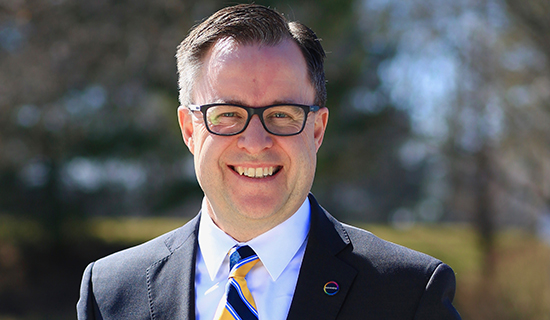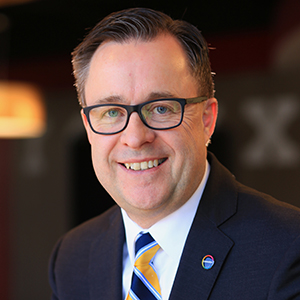Haakan Jonsson, Ph.D., jokes that most people are never more than a few feet away from materials made at Covestro LLC, where he serves as chairman and president. The company, which spun off from the Bayer Group as Bayer MaterialScience and rebranded as Covestro in 2015, manufactures high-tech polymers for plastics, polyurethane foams, coatings and other materials used in mattresses, laptops, shoes, building insulation, automotive parts and more.
Jonsson joined Bayer as a scientist in 1992 after earning a master’s degree in chemical engineering and a doctorate in polymer technology at the KTH Royal Institute of Technology in Sweden, where he was born. He’s been with the company ever since, working in a variety of job functions and geographic locations. Over his 30-year career at the company, he has overseen manufacturing, innovation, business development and supply chains in both North America and Europe, moving from Pittsburgh to Ohio to Germany (home of the company’s global headquarters) and back to Pittsburgh, where the company’s U.S. operations are based.
While innovation has always been part of his job responsibilities (and often in his title), Jonsson says Covestro is successful because innovation is embedded throughout the entire organization.
“Innovation is the foundation of our company,” he says. “It’s not just the explicit responsibility of those who have it on their business card, those who carry the titles of scientists or engineers. For us, innovation is something that happens across the whole company — and that is contributing to our success.”
Here’s how Jonsson sets an expectation of innovation at every level.
Setting a clear vision
At Covestro, innovation starts with a clear strategic vision. Communicating that vision to all 2,800 employees at 13 U.S. locations is a constant challenge that has been further exacerbated by the pandemic. Although Jonsson had been serving as president and managing director of Covestro since 2018, he transitioned into his current role in January 2020, just months before COVID shuttered the global economy.
“While I was somewhat new to this role, I was not new to crisis management,” says Jonsson, who spent years managing labor and supply chains across the company’s manufacturing operations. “It was a pretty scary time, and as leaders, we had the responsibility of making sure that we could continue to operate, as we were deemed part of the critical infrastructure. We managed by making real-time decisions and constantly staying in contact with our employees.”
Early on, Jonsson pulled together a multidisciplinary team called the Pandemic Steering Committee that met every day to discuss the challenges of the global crisis. He also led a U.S. Country Council consisting of functional leaders throughout America, who applied the steering committee’s insights at the operational level. Then, those decisions trickled down to the leaders at each facility through companywide best practices.
Through this tiered approach to crisis management, Jonsson maintained transparent communication with employees through virtual town hall meetings and remote roundtable discussions. These forums included opportunities for employees to ask questions and share ideas, ensuring that leaders heard concerns bubble up instead of just communicating in one direction.
“The leaders of the company develop the strategy, but the strategy is never going to be successful if it stops within the four walls of a boardroom,” he says. “It needs to be communicated and understood by the employees at all levels so we can all pull in the same direction.”
These multilayered back-and-forth communications kept the company moving forward with resiliency as Covestro charted a new course to emerge from the challenges even stronger.
“To be resilient, you can’t just manage today’s challenges; you also need to look forward. You cannot forget about the strategic vision and mission, even in the midst of a crisis,” Jonsson says. “By rolling out a new strategy in the midst of the pandemic, that told our employees there is a tomorrow. Even though things are dark, by looking forward to what you want to achieve, you’re making a compelling case for a bright future.”
Making (less of) an impact
The forward-looking strategy Covestro rolled out during the pandemic centered around sustainability. The company set ambitious goals to improve its environmental impact by reducing greenhouse gas emissions, with a vision to achieve net-zero status by 2035.
“The chemical industry is resource-intensive — we use a lot of fossil fuels as an energy source and as a raw material — so resource scarcity is a big challenge for us,” Jonsson says. “That’s why we believe that the chemical industry needs to lead the transition to becoming more sustainable. We have to get away from this ‘make, take, waste’ model we have today. We want to become fully circular, where we use our products over and over, so we can continue to keep the finite resources we have in use.”
To become fully circular, Covestro is focusing on three main areas: using renewable energy, recycling products and reducing its dependence on fossil fuels by sourcing more sustainable materials. For example, to keep memory foam mattresses (which are made of polyurethane) out of landfills, Covestro is developing new processes to recycle materials by breaking them down into chemical components that can be reused.
Covestro is also exploring alternative bio-based materials. One example is a new coating, traditionally manufactured using fossil fuels, that’s being made from plant-based materials instead. The coating will be used in automotive, construction, furniture and textile applications. “We’re developing products that also help our customers become more sustainable,” Jonsson says.
Realizing that sustainability is a much larger goal than any company can achieve alone, Covestro leans on partners across its entire value chain. The company is even collaborating with the University of Pittsburgh to develop a new graduate-level program to address the challenges of global waste and material use. The Covestro Circular Economy Program will feature coursework focused on innovative design solutions that consider the complete product lifecycle. The first-of-its-kind program also provides research opportunities, with an innovation component that acts as an incubator to commercialize inventions generated through the program.
“The fundamental question is, how do we design sustainable products for the future?” Jonsson says. “If you can educate tomorrow’s designers and engineers, then you’re one step ahead already.”
Encouraging innovation
To generate the kinds of industry-leading innovations that can solve big problems like improving energy efficiency, Covestro expects creative thinking at every level of the organization.
“We encourage our employees to challenge everything,” Jonsson says. “Don’t continue doing something that way just because we’ve done it for 50 years. Come up with new ideas. How can you do it differently? How can you do it better? That innovation mindset is definitely something that we encourage and try to keep top of mind. Innovation is an expectation, but also an opportunity.”
Covestro employees quickly learn that innovation is central to the company culture. In fact, Jonsson says that’s why employees like him stay for so long, because the culture empowers people to carve out new opportunities while creating solutions to real problems.
“It’s an opportunity for all of us to influence how we do our daily work and contribute to the success of the company,” he says, “with the intent that it’s going to be more efficient and effective to the benefit of everyone working here.”
The company even rewards new ideas with an annual innovation celebration to recognize employees’ contributions. Whether it’s a new patent, manufacturing process, supply chain solution, go-to-market strategy or safety advancement, “we celebrate those to show people that anyone in the company can be an innovator,” he says.
The key is getting people on board and excited about innovation, Jonsson says.
“It’s not only about the products we make; it’s also the people who are doing it and the purpose of why we’re doing it. We provide purpose to our employees, so they’re motivated not only to understand the strategy, but to live and drive the strategy. They’ll pull harder in the same direction if they’re well-aligned with that purpose.”
Seeing ideas in action
One way Covestro motivates employees is through fun challenges like “Rethink the Rink,” a partnership with the Pittsburgh Penguins and Carnegie Mellon University (CMU) that’s focused on making hockey safer through innovation. The annual make-a-thon, which began in 2018, challenges CMU students to develop new material solutions to address specific safety concerns in the sport. Teams of students work closely with experts from Covestro throughout the weeklong competition, and the winning prototypes are tested on the ice.
In its first year, the program asked teams to rethink the dasher board system surrounding the rink. Covestro partnered with Athletica Sport Systems Inc., a leading dasher board manufacturer, to bring the winning innovation to market. The material, which improves energy absorption upon contact by up to 65 percent, was commercialized last year and installed at the Covestro Innovation Rink, the Penguins’ practice facility in UPMC Lemieux Sports Complex.
“Employees can go watch the Pens practice and actually skate in that rink and see in real life what can come out of innovation if you think outside the box,” Jonsson says. “I’m very proud of the products made from our materials, and that comes with a purpose that we make the world a brighter place with our materials.”
Covestro’s culture of innovation constantly reminds employees that they’re not just developing advanced materials but creating solutions to big problems like safety, sustainability and energy efficiency.
“It’s easy to look at those as huge challenges and problems,” Jonsson says. “Here, we look at it as an opportunity. We cannot fix all the issues in the world, but we will be part of the solution.” ●
TAKEAWAYS
- Stay focused on your strategic vision, even during crisis.
- Imagine new ways to reduce your environmental impact.
- Encourage innovation at every level of the organization.
- Motivate employees with a purpose that transcends products.


